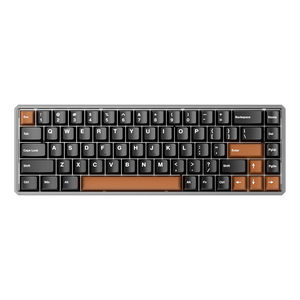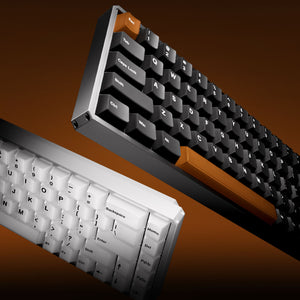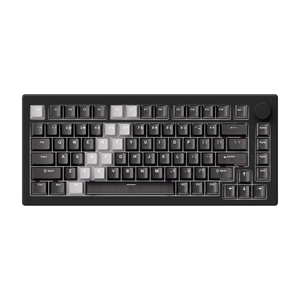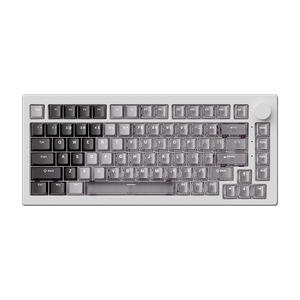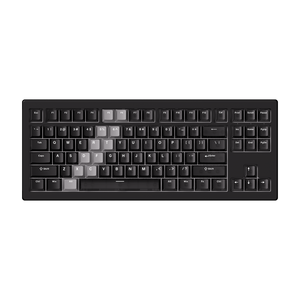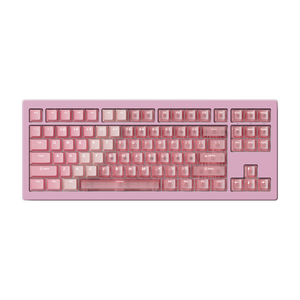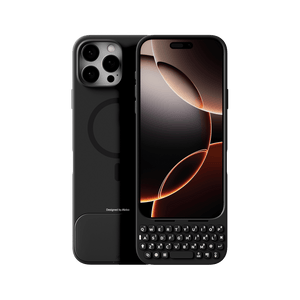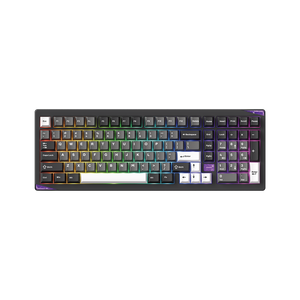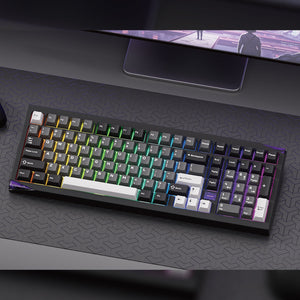When it comes to computer mice, weight is more than just a technical specification—it significantly influences how you move, aim, and maintain control in your game.
Some users prefer ultra-lightweight models for maximum speed, while others prefer heavier mice for greater stability. This choice reflects important considerations for comfort, performance, and long-term hand health. Let's take a closer look at the topic of mouse weight.
Typical weight categories of mice
Lightweight (under 70 g)
Designed for maximum agility, they're especially popular with competitive FPS gamers. Often featuring perforated casings and reduced components to save weight.
Advantages:
- Lightweight: Less fatigue; ideal for gaming and long-term use.
- Portable: Easy to transport.
- Responsive: Fast movements, perfect for FPS/MOBA games.
- Minimalist design: fewer parts, lower risk of failure.
- Balanced wireless options: Lightweight yet with good battery life.
Disadvantages:
- Little hand support: Can cause fatigue with prolonged use.
- Durability: Thinner cases wear out faster.
- Shorter battery life: Wireless models need to be charged more often.
Standard weight (70 g – 100 g)
The most common category with a good balance between speed and control.
Advantages:
- Balanced performance: Medium weight, flexible and stable; suitable for gaming, office and design.
- Comfort & Function: Ergonomic with palm rest; often with side buttons and tilt wheel.
- Good value for money: Solid performance at fair prices.
Disadvantages:
- Less portable: Heavier than lightweights, not ideal for traveling.
- Simple design: Some models appear plain or unstylish.
Heavyweights (over 100 g)
They focus on maximum stability and often on additional features such as more buttons, batteries (for wireless models) or adjustable weights.
Advantages:
- High stability: More weight ensures precision, e.g., in RTS games or design work.
- High-quality workmanship: Metal frames or weight blocks provide a solid feel.
- Ergonomic: Large shape with strong palm rest for long sessions.
Disadvantages:
- Low mobility: Bulkier and less travel-friendly.
- Hand fatigue: May occur with prolonged use.
- Higher price: Usually positioned as premium models.
Factors that influence mouse weight
The weight of a mouse is determined by several factors, including materials, design, features, connection type, and more.
1. Housing materials
Lighter mice often consist of hollow or honeycomb casings, thin plastic, or lightweight materials such as magnesium alloy.
Heavier models, on the other hand, use dense plastic, metal frames or rubberized coatings for better grip and greater durability.
2. Internal components
- Battery size (for wireless mice): Larger batteries offer longer runtimes but increase weight.
- Sensor unit: High-performance sensors can vary slightly in weight.
- Circuit board and switches: More buttons or extended functions increase the weight due to additional circuits.
3. Shape and size
Larger mice naturally weigh more due to their larger surface area and internal volume. Ergonomically designed models also often use more material to increase comfort and grip.
4. Functional configuration
Some mice feature modular weight compartments. Users can add or remove small metal weights to customize the weight distribution (front, center, or rear).
5. Connection type
Wired mice do not require a battery and are therefore usually lighter.
Why does mouse weight matter?
1. Affects control and precision
Lighter mice allow for quick flicks and responsive movements – especially beneficial in fast-paced FPS games like Valorant or CS2 , where every millisecond counts.
Heavier mice, on the other hand, offer more control and stability. They help smooth aiming and are therefore popular for strategy or MMO games where reaction time is less critical.
2. Affects comfort and fatigue
Lightweight mice reduce fatigue but may lack hand support.
Heavy mice offer more stability, but can be stressful in the long run.
A constant mouse weight also contributes to the development of muscle memory in aiming, tracking and moving.
3. Influences mobility and intended use
Lightweight mice are more portable, but often lack certain features.
Heavy mice are better suited for stationary setups, but are less flexible.
4. Affects functionality and durability
Lightweight models usually offer fewer features and may be less durable due to thinner materials.
Heavier models often have more features and a more robust construction, but they don't suit every user style. The choice depends on your priorities.
5. Influences usage habits
Lightweight mice relieve strain on the hand muscles and are well suited for long usage sessions.
Heavy mice offer more palm support and relieve pressure on the wrist.
Choose the appropriate weight depending on your grip style (palm, claw, etc.) and hand shape.
Does weight affect DPI?
Technically speaking, no. Mouse weight has no direct influence on DPI (dots per inch), or sensor sensitivity.
But: Weight and DPI together affect the feel and control of the game.
-
Lightweight mice allow for faster and more frequent movement, making lower DPI settings feel smoother and more precise—ideal for FPS accuracy.
-
Heavy mice are slower, so gamers often prefer a higher DPI to get by with less movement.
How do you choose the right mouse weight for you?
1. According to your usage scenario
For gaming:
- FPS games: Speed and precision are key here – ultra-light mice enable fast, flexible movements and are particularly popular.
- MOBA games: Medium-weight mice offer a good balance of control, stability, and comfort during complex actions.
- RTS games: Medium to heavy mice (100–130 g) provide precise control for frequent clicking and large-scale navigation.
- RPG games: Depends on your play style—medium mice (70–100 g) are comfortable, while heavier models (100–120 g) offer more control.
For office work:
A standard weight mouse is usually the most balanced and combines comfort and stability.
If the mouse is too light, fatigue can occur due to a lack of support; if it is too heavy, movement efficiency suffers.
For design/programming:
For precise dragging (e.g. in graphic design), a slightly heavier mouse is more stable.
If you click frequently, a lighter model saves energy and relieves strain on your fingers.
For mobile working:
A lightweight wireless mouse has a clear advantage here – it is easier to transport and saves space.
2. According to your grip style
- Palm Grip (whole palm rests): Standard to heavyweight mice offer better palm support and comfort – especially during extended use.
- Fingertip Grip (only fingertips touch the mouse): Lightweight mice are ideal – they relieve strain on the hand muscles and enable quick movements.
- Claw Grip (fingers curled, palm barely touching): Medium-weight models usually offer the best control and balance.

3. Try it yourself
If possible, test different mouse weights in person to find out what feels best for your hand.
Some models allow fine-tuning with adjustable weights , so you can individually adjust the weight and center of gravity to your grip style and usage – for optimal comfort and maximum control.
Akko Mouse Recommendation for Gaming
Pulse 01 Gaming Mouse

Top-of-the-line PAW3950 sensor: The Akko Pulse 01 is equipped with the state-of-the-art Akko Custom PAW3950 sensor and offers up to 30,000 DPI and 750 IPS – for outstanding precision and performance in every game.
Dual Nordic chips for maximum wireless performance: Two Nordic chips ensure an extremely responsive, energy-efficient, and reliable wireless connection – perfect for demanding competitive gaming.
8K Polling Rate: Supports a polling rate of 8000 Hz in both 2.4G wireless and wired operation – for lightning-fast signal transmission and maximum control.
Extremely durable switches: Equipped with Kailh GM 8.0 switches with a lifespan of up to 100 million clicks – ideal for long-term gaming without loss of performance.
AG ONE 3950 Hatsune Miku Gaming Mouse

Hatsune Miku Design: A real highlight for fans of the virtual pop icon: This gaming mouse brings the unmistakable Hatsune Miku style directly to your desk – perfect for style-conscious gamers.
Powerful PAW3950 sensor: Equipped with the high-precision PAW3950 sensor , the AG ONE 3950 offers exceptional accuracy and responsiveness , ideal for competitive gaming.
Dual-receiver convenience: Two receivers (8K and 1K) are included in the package – so the mouse can be flexibly adapted to your setup and performance needs.
8K Polling Rate: With a polling rate of 8000 Hz (supported in 2.4G and wired mode), the mouse offers extremely fast signal transmission – for maximum control in intensive gaming situations.
Durable Kailh GM 8.0 switches: The high-quality Kailh GM 8.0 switches offer a lifespan of up to 100 million clicks , making them a reliable long-term solution for heavy gamers.
Conclusion
Mouse weight is not the only factor in performance, but it does significantly impact comfort, efficiency, and long-term health .
Instead of chasing extreme light or heavy weights, you should choose a weight that suits your individual needs and usage habits .
The ideal mouse supports you both at work and when playing – comfortably and reliably .
FAQ
Is a 100g mouse good for FPS games?
A 100g mouse is on the higher end for FPS games, but it's not unsuitable - what matters is what feels natural to you and supports your precision .
If you value control over speed, or prefer slower-paced shooters, it may be a good fit for your style.
Is 80g heavy for a mouse?
At 80 g, the mouse is in the comfortable middle range .
Unless you're an extremely speed-focused FPS gamer, this weight will feel comfortable and balanced for most applications.


